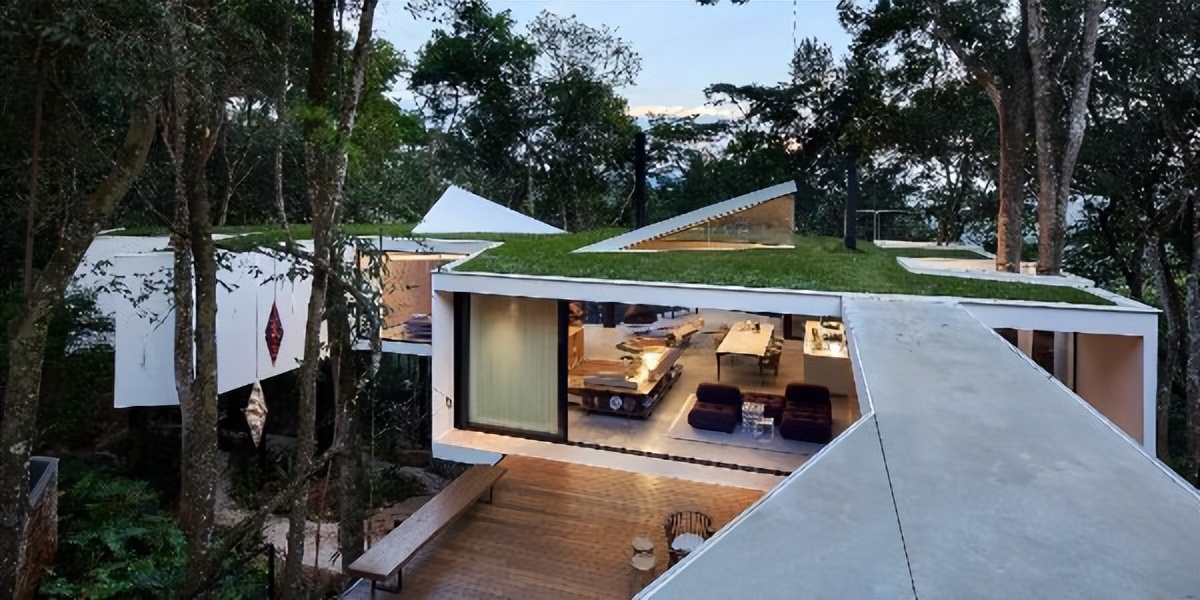
Casa Açucena residence in the center of a forest in Brazil, which rises 15 meters on the elevated road. Architecture studio Tetro studies the fusion of nature, using distinct materials and exploring empty spaces, placing their clients in the tradition of modern Brazilian architecture as a starting point before branching out to test the limits of contemporary architecture. Architects Carlos Maia, Débora Mendes and Igor Macedo argue that steep slopes are not a challenge to conquer, but rather an advantage to be maximized.
Immersed in the natural environment of the lush Atlantic rainforest, the terrain is home to leafy trees, leaves, shrubs, birds and wildlife, and the terrain is steep, typical of the New Lima region of Minas Gerais. Three architects decided to insert the residence into the heart of nature to satisfy the residents' desire for shelter and tranquility. Trees and branches rubbed shoulders with the building, covering the house with green. The spacious windows are paved with a boxy structure that reflects the natural image of the outside, completely blurring the space with glass material. The architects first noticed the local needs, which were then discussed by the owners of the dwellings.
The architect believed that natural features should be maintained and asked himself how he could complete the function on the steep terrain while maintaining contact with nature. They want the owners to have the experience of looking up at the sky every day and seeing the sky through the treetops. The architects raised the dwelling to a height of 15 meters above the ground to induce the owner to look upwards, from the ground and canopy to the sky. Carefully studied the premises and conditions provided by the location and the customer, and then blended them together in a way that perfectly combines with nature.
The Açucena House is characterized by the light and shadow of the white building components on the exterior and the structure with tension. When the owner walks around the room, the interior of the building is zigzag, like a labyrinth, but each functional area is the smallest and complete. The combination of wood and concrete, coupled with warm light, gives the interior a feeling of not being in a hurry, pulling the owner to slow down and savor the environment. Due to the abundance of light and the wide space, the tall ceilings and windows are also hallmarks of the construction of this residence, allowing for pacing within the room.
Soft, heavy curtains block view when necessary, perhaps to wrap occupants in a privacy basket when necessary, but they also add to the elegance and gentleness of the design. Stepping into the bedroom, residents can slide the windows to remove any obstacles between them and the forest. In the bathroom, there is a lonely bathtub by the window, suggesting immersing the body in a well-deserved meditation while admiring the view. Nature is here, there, anywhere, gazing at the swaying of the trees and listening to the rustle of leaves, you can reduce the weight of the burden.
Imagine working from home, after phone calls and meetings, sipping on your favorite drink with your shoulders resting on the window frame, gazing at nature's gifts and soaking up the relief of nature. As the house turns, the scenery changes with the elevated patio of the house. The wooden floors pay homage to the raw materials of nature, while the tall spaces invite people to party and party. Not far from this area, there is a swimming pool with a geometric shape that encourages people to go for a bath and see the sheer elegance of the greenery on the water. Casa Açucena despises indulging extravagant living through flashy property, and it prides itself on the classic feel of visiting your own holiday home outside the city.
The architects shared: "Architects understand that the architecture of a house should adapt to the topography, not the other way around. The house is above the ground and does not hinder the development of flora and fauna under the ground. Shaping himself by occupying the gaps between the trees, the architect reiterated that no trees were removed during the conception of the house and the terrain remained the same. For the three architects, art and nature flow perfectly upon completion. It is the residence of the artist, the Casa Açucena residence caters to the much-needed state of reflection and creation. The design scheme is not determined by the taste or will of the architect. Everything is in response to the nature around it."
This house, with its white tone, gives people a surprise. Its randomly placed black pillars blend in with the trunk, making the house look like it's floating in the air. Its fluid design, standing in the trees, the openings of the mass and the folds on the plates, the view above the top of the tree, all create a sense of volume. The building is harmoniously inserted next to the natural vegetation, and as the architect said, surprise and novelty are intrinsic values of art. Casa Açucena Residence is like a white flower in nature, allowing everyone who walks in to feel the fragrance of a desire for stillness, wildlife and tranquility.